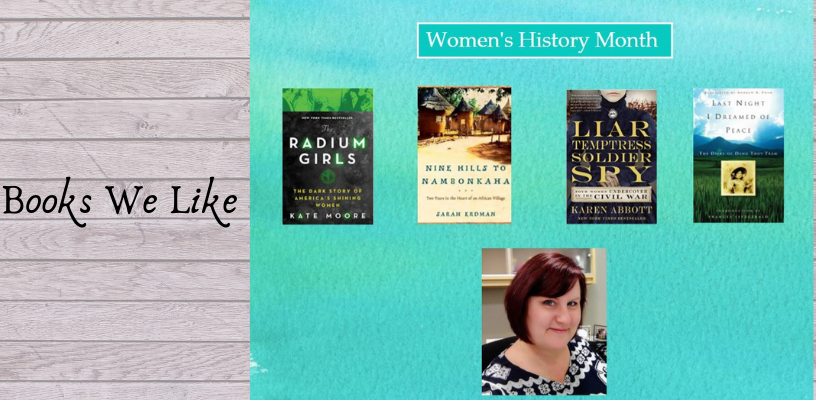More Books We Like
Need a New Author?
Get printable versions of these lists by clicking on the list name.
Books We Like: Women's History Month
Published 3/1/2021 by Karen Feeney

In honor of March being Women’s History Month, I want to share with you a few of my favorite books written by women. A shocking true story about factory workers who paid the ultimate price for corporate greed is told in “The Radium Girls: The Dark History of America’s Shining Girls” by Kate Moore. Soon after the Curies discovered the element radium, it became an ingredient in health tonics, cosmetics, and paint that glowed in the dark used for watch faces and clock dials. This is shocking in itself since radium was known by scientists to be dangerous. No one told the young women who flocked to the factories that manufactured glow-in-the-dark watches for WWI soldiers. They were instructed to “lip point” their camel hair brushes before painting each glowing numeral. As a result, after a few years of factory work, young women became very ill. They lost teeth, jaw bones, and grew tumors from the radium they had ingested. Moore describes the struggle of these women to hold their employers accountable for the misconduct that will cost them their lives. The book reads like fiction because Moore uses diaries, letters, and interview material to bring life to the real women of this story. It is decidedly a warning to people of the dangers of new discoveries used in business, and importance of worker safety. It is ultimately an underdog story, one of women’s persistence over their situations and their fight, despite failing health and incredible pain, to hold abusers accountable. “Nine Hills to Nambonkaha: Two Years in the Heart of an African Village” by Sarah Erdman really opened my eyes to the reality of how differently people live around the world. In this biography of her time in the Peace Corps, Erdman talks of her experiences as a health care worker in the rural village of Nambonkaha in the African nation of Côte d'Ivoire. She writes in what I would call a conversational tone. She relates her struggles to fit in with the small village, her missteps in trying to help the villagers, and her successes too. Using her diaries to recall her experiences, she shares with readers the daily lives of the people of this village, who were left mostly untouched by the outside world. She learns of their traditional ways, superstitions and magic, and works to help them prevent disease and malnutrition. This book stays with me because Erdman humbly brings the village and villagers to life in such a way that you feel that you are there with her, and you learn to care about the people she comes to care so much about. A fantastic work of nonfiction, “Liar, Temptress, Soldier, Spy: Four Women Undercover in the Civil War” by Karen Abbott tells the story of four women, two Union sympathizers and two Southern secessionists who, despite the limitations of their time, participated in the American Civil War. They came from different backgrounds and for various reasons, but they made an impact on the war by gathering information and passing that information to the men who made war. From dressing and fighting as a soldier, to using feminine wiles to obtain information, to running a spy ring at great personal risk, and running messages across enemy lines, each of these women took the opportunities afforded them by the upheaval of society to do what they thought was right for their country. As Abbott writes, “Each, in her own way, was a liar, a temptress, a soldier, and a spy, often all at once.” Meticulously researched, this book reads like fiction but is completely a work of nonfiction. The women’s own words, culled from letters, diaries, book, archival note, or family history, give life to these women in a way that will engage you, amaze you, and hopefully challenge your belief in who the people of the American Civil War were, and why they did what they did. One of the handful of books that I kept from my college days, “Last Night I Dreamed of Peace: The Diary of Dang Thuy Tram” by Ð?ng Thùy Trâm, translated by Andrew X Pham is an amazing insight into two years of a young surgeons life on the frontlines of the Vietnamese conflict between 1968-1970. Dr. Tram came from an intellectual Hanoi family and was just out of medical school when she headed to Quang Ngai province out of patriotism for her country and for love of a man called M in her diaries. Once there, she would spend the next few years in makeshift clinics helping wounded soldiers and villagers while trying to escape the escalating violence that tore her country apart. At times she writes about herself and her need for love and her youthful ideology. At other times, she relates the horrors and outrages of the atrocities she witnessed firsthand. Tram’s diaries were saved by a U.S. serviceman, Fred Whitehurst, who was carrying out orders to burn papers of no military value. His interpreter told him not to burn the diary “because it had fire in it already.” Because these men recognized the value of Dr. Tram’s diary, her words live on to this day. The first diary, and another that would make its way to Whitehurst, would eventually make their way back to her homeland and to her mother, to be printed with much celebration in 2005. This memoir has fire, it has longing for life, it has sadness, and it has compassion. It also has insight into the lives of the Vietnamese people during a catastrophic period in their country’s history. It has stayed with me and it will stay with you too.